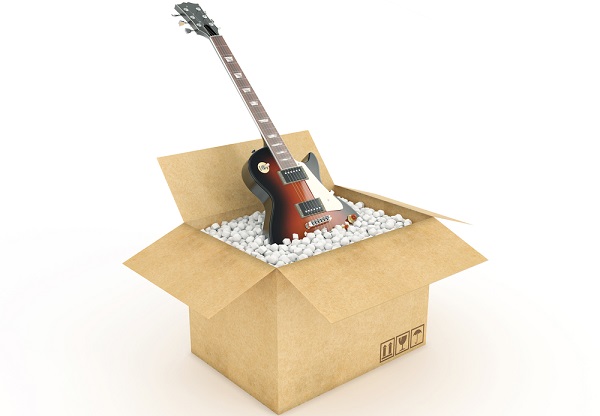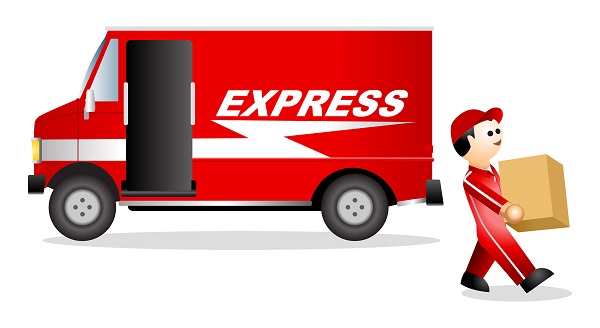Shipping your guitar without a case can be a nerve-wracking experience; if it wasn’t, guitarists like Eric Clapton wouldn’t waste money buying their beloved instruments the seat beside them when they fly.
Most of us can’t afford that extravagance, though; we have to accept that, for a short while, our cherished guitars will be treated with no more or less consideration than the hundreds of other packages being moved in and out of a cargo hold on any given day.
Fortunately, shipping your guitar without a case need not cost you any sleep. By packaging your guitar carefully and following the steps outlined below, you can help ensure your instrument will arrive at its destination in the same condition it was shipped.
Gather Necessary Materials
To prepare your guitar for shipping, you’ll need a few things, and it will save you time to have them ready. Here’s a list of what you’ll need to keep your guitar safe during shipping:
- Two boxes, ideally one guitar box and one slightly larger
- Packing material (card board rolls, bubble wrap, packing peanuts, newspaper, foam padding etc.)
- Rubber bands
- Packing tape
- Shipping labels
- Thin towel/washcloth
- FRAGILE and DO NOT LAY FLAT decals
All the abovementioned items are available wherever shipping materials are sold; even guitar shipping boxes and large guitar boxes are available through such sites as ULINE and Amazon.com.
Prepare and Secure the Guitar for Shipping
In preparing your guitar for shipping without a case, there are a few things you’ll want to do before you begin packing your guitar in the shipping box.
First, be sure to loosen or remove your guitar’s strings. Changes in temperature and air pressure accompanying changes in altitude can place undue stress on your guitar’s strings, and therefore on its body sides and neck.
Loosening or removing the strings is the best way to protect your guitar strings from stress damage during transit.
Consider the climate if shipping during extreme heat or cold. Avoid shipping guitars in very hot or cold weather, as temperature extremes can damage the guitar body.
To protect your guitar’s fingerboard, consider placing a thin towel or washcloth between your guitar’s loosened strings and fretboard. This will prevent string damage to the fretboard if the strings shift during the shipping process.
Next, you’ll want to remove any loose accessories. You don’t want loose items potentially scratching or damaging your guitar finish in transit. If you use a clip-on tuner or a capo, for example, take them off before wrapping the guitar for packing in the box to ship. If your guitar has a tremolo (whammy) bar, be sure to remove this too.
Wrapping and packing your guitar properly is crucial to prevent damage during shipping. Wrap as much of the guitar in bubble wrap as is practical or possible to prevent the guitar from moving around inside the packing box.
When wrapping the neck, brace it by creating a cardboard support structure that runs from the guitar body along the length of the neck and extends just beyond the headstock. This helps prevent neck/headstock damage if the shipping box is dropped.
Also, secure the bubble wrap with either rubber bands or packaging tape. If you have a soft gig bag, this can provide an extra layer of shock-absorptive padding.
If you use packaging tape, or any other kind of tape to secure your guitar, be sure it only ever comes into contact with packing materials and not your guitar’s finish or other metal components.
Packaging the Guitar for Shipping

Once you’ve loosened your strings, removed any accessories, and wrapped your guitar in bubble wrap, it’s time to package. Any box will work, but a guitar box is preferable, as they’re shaped specifically for the purpose and will therefore have less open space.
Before boxing your guitar, line the bottom of the box with extra bubble wrap or packing paper (crumpled newsprint works well too.) Be generous with packing material; you don’t want any part of your guitar accidentally making contact with the cardboard box itself during shipping.
After placing your guitar into the box, you’ll need to pack the spaces all around the instrument with packing material. No part of your guitar should contact any of the box’s sides.
Using crumpled paper, light towels, or bubble wrap, pack any and all empty spaces. The idea is to immobilize your guitar as much as possible while providing a measure of shock absorption.
As you pack the box, pay special attention to your guitar’s neck. Keeping the neck stable is, perhaps, the most important part of keeping a guitar safe during shipping. Be sure the neck is completely surrounded and supported with shock-absorptive packing material like bubble wrap or crumpled packing paper.
Before closing and sealing the box, you’ll need to cover your guitar with a few inches of packaging paper, newsprint, or thick bubble wrap. You could also use folded towels; anything firm enough to hold your guitar in place while soft enough to absorb potential shocks.
Now it’s time to close and seal the box. When placing the cover on the standard shipping box, pay attention to how easily it moves into place; a well-packed guitar box should offer just a little resistance to being fully closed.
You shouldn’t have to press too hard to get the box closed, though; if you find yourself having to press down hard to get the lid on, you’ve likely used too much packing material.
When sealing the box, don’t be afraid to go overboard with the packaging tape. Keeping the guitar shipping box closed, and therefore protected, is of the utmost importance, and worth the meager cost of a bit of extra shipping tape.
The Shake Test
Once you’ve closed and sealed the guitar box, pick it up and give it a good shake. You’ll be able to feel and hear if your guitar is moving within, and if it is, now’s the time to reopen and add more packing materials.
Remember, the more your guitar moves within the package the more likely it is to be damaged in shipping; ideally, you don’t want to feel or hear any movement from within the package when you perform the shake test.
Now that your boxed guitar has passed the guitar packing shake test, it’s time to consider double boxing.
As touched on briefly above, the ideal way to ship a guitar without a guitar case is to double box it, placing a guitar box inside a standard outer shipping box; this adds an extra layer of security should the package be accidentally swiped or punctured while in transit.
If you double box your guitar, be sure to pack any and all voids between the first and second boxes with generous amounts of packing material.
Once you’ve sealed the empty space in the second box, perform the shake test again. If you feel any more than the barest of movement within the box, you likely need to add more packing material.
Labeling and Addressing the Package

Before shipping your guitar, you’ll need to affix destination and return address labels to the box. Clear packaging tape is a great way to make sure this crucial information remains visible and stays adhered to the package.
Now your guitar is properly packaged and labeled with its destination and return address labels; that’s great, but don’t put away that packing-tape dispenser just yet. There are a few more labels you’ll definitely want to add to your packaged guitar: namely, “FRAGILE” and “THIS SIDE UP.”
Baggage handlers aren’t going to be on the lookout for your prized guitar; their job is to load cargo as quickly and efficiently as possible without causing damage. The last thing you want is for your carefully packed guitar to wind up lying flat in a cargo hold with other packages stacked on top of it.
So, before you hand your lovingly packed instrument to a courier or shipping company, be certain to affix at least one large “FRAGILE” decal to both the top and bottom of your package, along with at least two large decals reading “DO NOT LAY FLAT.”
Shipping the Guitar
Speaking generally, there are two options when it comes to shipping a guitar without case: you can pack the guitar yourself and ship it with a delivery service like UPS, FedEx, or USPS, or you can employ the services of a shipping company to pack and ship your instrument for you.
For maximum protection and security, consider using an expedited shipping service like overnight delivery. The faster the shipping time, the less handling and chances of damage in transit.
Shipping with a Courier Service/Shipping Company
If the guitar you’re shipping is particularly valuable, consider using a specialty courier or boutique shipping service. Though more expensive than standard shipping, these companies specialize in transporting fragile, high-value items and provide white glove service ensuring your guitar is professionally packed and handled with care.
Additionally, having the guitar packed by a shipping company provides more recourse in case of damage, as they assume liability when packing instruments themselves.
If you choose to ship your guitar with a courier service or shipping company, be sure to ask if there’s a cap on the amount insurance will cover. If so, you may be able to purchase additional insurance to cover the full value of your guitar.
The downside to letting a professional shipping company or courier service pack and ship your guitar for you is the added cost. Shipping a guitar is likely to cost you between fifty and one hundred dollars before the added costs of using a professional shipping company to pack your guitar.
What to Consider When Choosing a Courier

Whether you choose to let a professional shipping company pack and ship your guitar, or just use them to deliver it from point A to point B, there are a few things to consider when finding the right courier service. Here are a few to keep in mind:
Do They Allow Tracking of Your Package?
One thing to consider when selecting a courier for your guitar is whether or not they provide tracking for your package. Should there be any delays in delivery or other unforeseen problems in transit, you’ll want to know exactly where your guitar is at all times.
Do They Insure Your Package?
As mentioned above, most shipping companies will insure packages they pack themselves. Most also cover packages they deliver, but it’s a good idea to ask about a company’s insurance policy before shipping with them.
If the amount of coverage they offer is too low compared to the value of your guitar, ask about purchasing additional coverage, or look for another courier.
Do They Have a Service Requiring Signature Upon Delivery?
When shipping a guitar, even if it’s to yourself, it’s always a good idea to require a signature for delivery.
Often, this service is more expensive than other shipping options, but you’d do well to pay the extra fee yourself (or include it in shipping costs, if selling a guitar) as a safeguard against misdelivery or theft.
Shipping a Guitar Internationally
The tips mentioned above are all you’ll need to ship your guitar anywhere in the United States, but if you’re planning on shipping electric or acoustic guitar internationally, your best bet is to use an international courier service.
There are several things that can potentially cause problems when shipping a guitar internationally. For example, some guitars are made with materials considered restricted, like ivory and Brazilian rosewood; under some circumstances, licensing may be required for shipping guitars containing such materials.
International shipping companies will know when such licensing is necessary, and how to go about getting it; for this, and many other reasons, it’s usually easiest, and safest for your guitar, to ship internationally using an international courier service.
About the Author
Fabian, a Brazilian guitarist now based in Dublin, Ireland, has passionately played the electric guitar since 2003. As a luthier and product specialist, he boasts nearly two decades of collaboration with top musical instrument brands. Fabian is a sought-after expert, sharing his extensive knowledge with fellow guitar enthusiasts.



